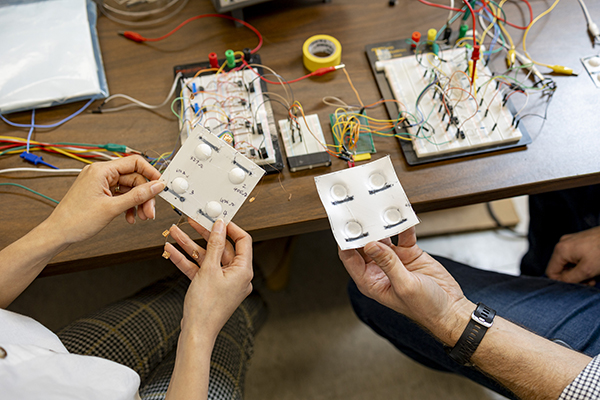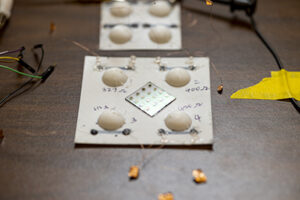 By Kathy Williams. Photography by Shawn Poynter.
By Kathy Williams. Photography by Shawn Poynter.
Small domes, like the ones on to-go cup lids and pop-it toys, may one day help drones sense and react to danger more quickly.
Drones can navigate without human control but are slow to respond to changes in their environment and, unlike humans, are unable to filter out useless information. This is due to an issue called data drowning, in which a drone’s sensors generate more data than it can process, preventing it from being able to safely fly in certain situations.
Drones may soon no longer have this problem, thanks to research conducted at the University of Tennessee and Purdue University with $1 million in funding from the Nature as Computer Program in the US Department of Defense’s Defense Advanced Research Projects Agency.

A prototype metasheet with invertible domes (~12 mm diameter) and built-in strain sensors (black stripes) was shown to exhibit bio-inspired mechanosensing and retrievable memories when wired to microscale memristors deposited on the square glass substrate.
A research team from the two universities studied materials that may enable the addition of small invertible domes on a drone’s wings, which will allow the drone to remember in microseconds what dangerous conditions feel like and react quickly.
Their research is the first time an engineered metamaterial has demonstrated the ability to use its own changes of shape to learn how to adapt to its surroundings on its own.
“We were able to prove the concept that a new type of reconfigurable material can deform, sense, and remember information,” said Andy Sarles, MABE associate professor and co-PI on the two-year project. “This type of functionality could enable robot hands, tools, or skins to more intuitively interact with their surroundings.”
The basis for the team’s overall approach is a new type of multistable reconfigurable mechanical metasheets, or metamaterials, that were first developed and fabricated by Associate Professor Andres Arrieta’s team at Purdue. These metasheets consist of flexible plastic sheets that feature a patterned array of reconfigurable bistable domes that can be popped in or out. Depending on how the domes pop on certain parts of the wing, the drone’s control system could sense a dangerous pressure pattern, dangerous temperature, or possibly even another object that is approaching.
“To retrieve information about the conformation of the sheet, the state of the system must be sensed at the local dome level,” explained Sarles. “What we investigated was to incorporate resistive sensors printed into the metasheets and connect these to resistive memory elements, known as memristors, to provide sensing and memory storage.”
At UT, former doctoral student Subhadeep Koner and former postdoc Yongchao Yu developed a scheme to integrate the domes with the sensors and memristors with the goal of using dome-popping events to incrementally program and store changes in the memristance.
The research shows that sensors embedded in the metasheets can detect the change in shape when force causes a dome to invert. An electrical signal then triggers the memristor to record the event and remember which dome was inverted on the sheet. Each time a dome is inverted, the metasheet learns the pattern of forces, such as those associated with a dangerous condition.
The research team’s next step is to test how the material responds to its surroundings based on information it learns from the domes. They anticipate being able to build a drone wing using this material design in the next three to five years.